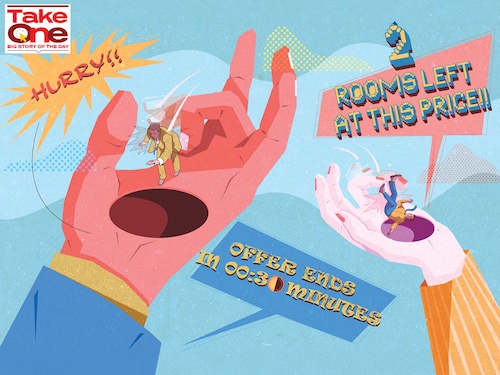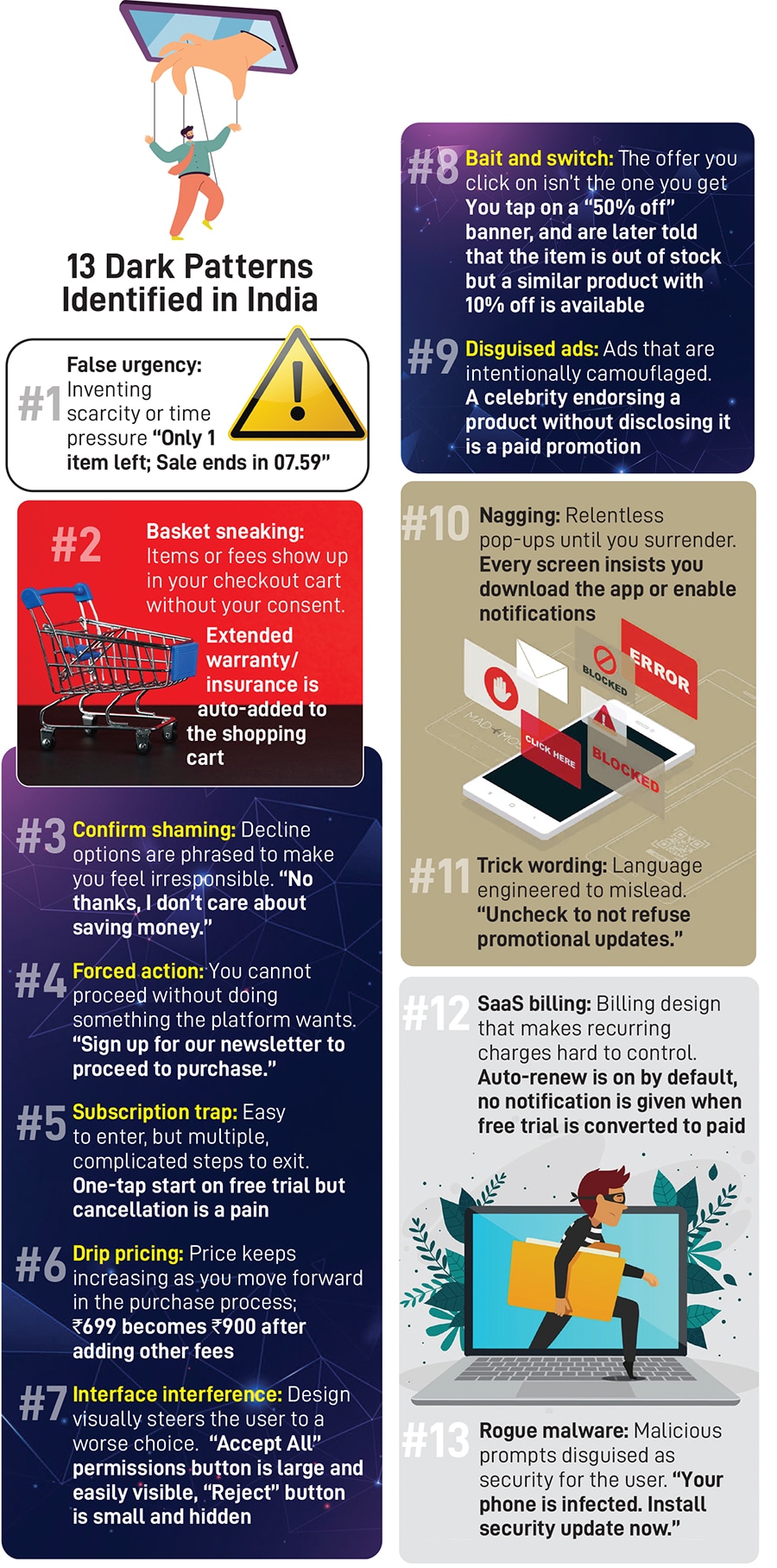Click, buy, regret: The dark patterns within online platforms
LocalCircles found 97 percent of Indias 290 ecommerce platforms use dark patterns. Only Meesho was free of them. CCPA guidelines exist but enforcement and penalties remain weak.


This festive season, the surge in online shopping in India’s $125 billion ecommerce market was accompanied by another rise: Complaints regarding dark patterns. Although such tactics may be in force round the year, the festive season, which brings along heavy discounts and frenzied shopping, is fertile ground for ecommerce platforms to double down on them.
In an attempt to study these patterns and practices, LocalCircles, a Noida-based community forum and pollster that works with the Department of Consumer Affairs, conducted a survey, as the discount season began on September 22, with Navratri. “Our four month-long survey closed on September 30,” says Sachin Taparia, co-founder of LocalCircles. “Between 30 and 35 percent of all complaints came during the last week.”
A September report by LocalCircles found that about 97 percent of India’s 290 major online platforms manipulate user decisions with what is called ‘dark patterns’. On November 30, 2023, the Central Consumer Protection Authority (CCPA) had notified the guidelines for Prevention and Regulation of Dark Patterns. Thirteen dark patterns were named under these guidelines: False urgency, basket sneaking, confirm shaming, forced action, subscription trap, interface interference, bait and switch, drip pricing, disguised advertisements, nagging, trick wording, SaaS billing and rogue malware.
In June, the CCPA issued an advisory recommending all ecommerce platforms to conduct self-audits in three months to identify dark patterns on their systems. The Department of Consumers Affairs has set up a Joint Working Group to check for violations, with notices being sent to those found indulging in dark patterns. Fines between ₹10 lakh and ₹15 lakh can be imposed, following investigations. So far, only Flipkart and BigBasket have announced the completion of their self-audit.
The festive season is when ecommerce platforms earn a significant portion of their yearly revenue. According to Datum Intelligence, ecommerce sales jumped 31 percent during this festive season to ₹1.24 lakh crore, which is expected to account for roughly 15 percent of annual sales.
“People work the entire year for festive season sales, and targets are set months in advance,” says a former Flipkart employee. “There’s an immediacy at Flipkart to reduce its monthly cash burn as it prepares for a public listing.” Amazon, too, is reported to be under pressure to boost profitability in India as it prepares to list on the bourses; it turned operationally profitable only last fiscal, after operating in India for 12 years.
A 2021 study by University of Chicago Law School said users exposed to dark patterns were almost four times as likely to sign up for a dubious service as those assigned to a control group. “When dark patterns were employed, the cost of the service offered to consumers became immaterial. Decision architecture, not price, drove consumer purchasing decisions,” found the study by Jamie Luguri and Lior Strahilevitz.
The effect is magnified during festive months, explains Tanvi Gupta, assistant professor of marketing at the IIM-Ahmedabad. “People are in a different mindset during the festive season compared to a normal day. They are not processing information deeply.” Vulnerable segments—older shoppers, those less versed in technology—are especially exposed.
The design of user interfaces (UI) and user experiences (UX) on ecommerce platforms—the process of how options are presented to users, or the “decision architecture” that the University of Chicago Law School study talks about—is a significant factor that contributes to dark patterns. “Most designers are unaware of dark patterns,” says Preeti Singh, a UI/UX designer with nearly two decades of experience. “While designing a website, we are frequently asked to include practices that are dark patterns. But as a designer, there’s only so much you can do.” Many companies, she and others note, see these patterns as the accepted “template” of the online world rather than deliberate manipulation.
Manisha Kapoor, CEO and secretary general of the Advertising Standards Council of India, says: “Some platforms intentionally deploy these patterns to manipulate consumers. But there are many others who are doing it almost because this is the template of the online world and that template itself is flawed.” Sometimes, the difference between legitimate urgency and deception is paper-thin, adds Kapoor. “Like an airline telling you only three seats are left. That information is helpful to the consumer, if true. But if false, it’s a dark pattern,” adds Kapoor.
Behind every surreptitious nudge, forced click and hidden cost is an industry struggling for profitability. Numbers like conversion rates and profitability per user rule all decisions. “Many platforms have a short-term focus when it comes to marketing. They want to monetise every consumer and if somebody gets on to a subscription plan, they want to maximise the customer lifetime value,” says Gupta. “But they are losing sight of the brand’s long-term perspective, of building trust and authentic customer-brand relationships.”
Taparia of LocalCircles calls order cancellations by platforms a “forced action dark pattern” where a platform forces the consumer to buy some kind of a priority pass to get access to special prices but then cancels the order later. “We have seen this repeatedly this festive season. This is a classic dark pattern because the platform made money on the priority pass. It has got its sales, so its overall numbers are going to be inflated. The platform’s cancellations are also going to be high, but they report it later. It’s something that is built into the design.”
Also Read: CoD fees, delayed refunds, false scarcity: E-commerce dark patterns explained
Direct-to-consumer fashion brand Snitch, which has forayed into quick commerce, feels consumer awareness has grown rapidly. “This is especially true for Gen Z and digital-first shoppers, but dark patterns still catch people off guard, particularly during high-discount periods when impulse decisions are common,” says Chetan Siyal, chief marketing officer, Snitch. “That said, today’s consumer is far more alert and vocal. They notice, compare and call out shady practices.”
An Amazon India spokesperson says it believes in transparency and works to ensure that deceptive design practices do not exist. “We implement comprehensive safeguards across the customer journey and our user interface undergoes rigorous evaluation against strict ethical design criteria, with customer needs and transparency serving as the cornerstone of all design decisions,” the spokesperson adds.
Quick commerce platform Zepto acknowledged it had some dark patterns which it removed. “We experimented with delivery fees and pricing, which was not received well on social media. A lot of the feedback was valid. We shouldn’t have done that. It was a mistake,” says Aadit Palicha, co-founder and CEO of Zepto. “We want to be a customer-centric company, and we were getting consistent negative feedback from consumers. So we said: This is not who we are, and now it’s gone.”
The LocalCircles survey found Meesho, India’s third-largest retail ecommerce player, to be the only platform that is free of dark patterns. “The Meesho example shows the issue can be fixed and that it’s a matter of the management deciding that this is something that needs to be addressed,” says Taparia. Flipkart, Myntra, BigBasket, Swiggy, Zomato and others did not reply to requests for comment.
Despite the guidelines issued by CCPA, compliance and penalties in India remain weak. Self-audits by companies are voluntary and not mandatory, and no penalties are imposed for not completing the process.
“The Federal Trade Commission in the US has been taking some action regarding dark patterns that exist in the US industry. The Digital Services Act (DSA) and the proposed Digital Fairness Act in the EU also talk about tackling ecommerce dark patterns. It’s interesting to note that these approaches have largely been based on the ‘choice architecture’, unfair design and transparency,” says Nikhil Narendran, partner, technology, media and telecommunications at Trilegal, a law firm. “India should follow suit and take a principle-based approach to it rather than being prescriptive with respect to the dark patterns.”
Given the legal frameworks and checks in other markets, in September, Amazon.com agreed to pay $2.5 billion to settle a US government lawsuit over such practices, while not admitting to the use of dark patterns. Under EU laws, fines imposed under the DSA can amount up to 6 percent of the global turnover, while under the AI Act, penalties can be up to 7 percent.
In India, fines are a pittance compared to the revenues generated by the companies. The CCPA imposed penalties totalling ₹1.1 crore in 2024 for consumer rights violations, which included unfair trade practices and misleading ads. Dark patterns are treated as unfair trade practice in India.
First Published: Nov 26, 2025, 11:23
Subscribe Now(This story appears in the Nov 28, 2025 issue of Forbes India. To visit our Archives, Click here.)
